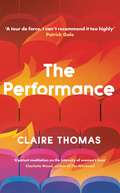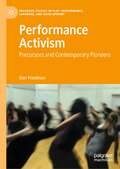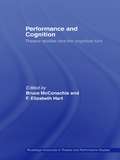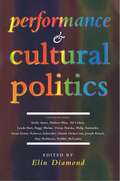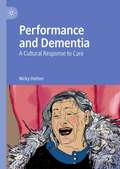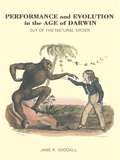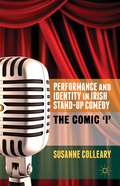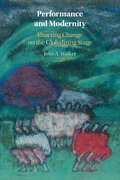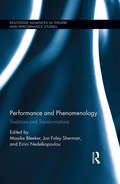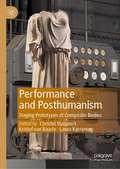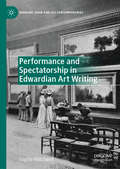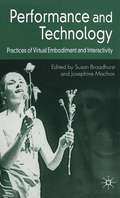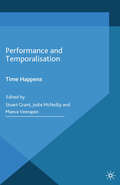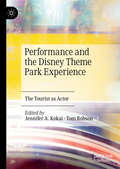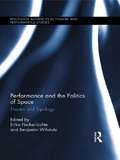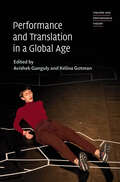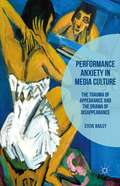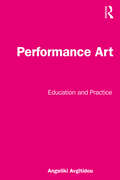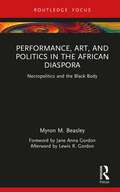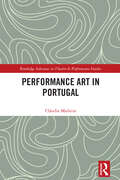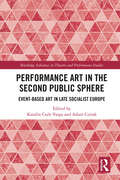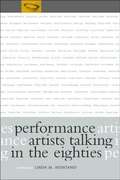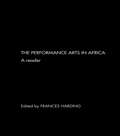- Table View
- List View
The Performance: A Novel
by Claire Thomas'Quietly transformational'The Times 'A tour de force... I can't recommend this too highly'Patrick Gale'Innovative... an original, at-a-sitting read'Daily Mail'A potent meditation on the intensity of women's lives'Charlotte Wood, author of The Weekend'A miracle... Engaging and evocative'Washington Post'I loved and admired The Performance... Unmissable'Emma Stonex, author of The Lamplighters'Lively and intimate... The way Thomas plays with the reader is a sort of genius'Guardian'Thomas writes these women with such wisdom and compassion, that by the end we are all transformed'Claire Fuller, author of Unsettled Ground The false cold of the theatre makes it hard to imagine the heavy wind outside in the real world, the ash air pressing onto the city from the nearby hills where bushfires are taking hold.The house lights lower.The auditorium feels hopeful in the darkness.As bushfires rage outside the city, three women watch a performance of a Beckett play.Margot is a successful professor, preoccupied by her fraught relationship with her ailing husband. Ivy is a philanthropist with a troubled past, distracted by the snoring man beside her. Summer is a young theatre usher, anxious about the safety of her girlfriend in the fire zone.As the performance unfolds, so does each woman's story. By the time the curtain falls, they will all have a new understanding of the world beyond the stage.
Performance Activism: Precursors and Contemporary Pioneers (Palgrave Studies In Play, Performance, Learning, and Development)
by Dan FriedmanThis is the first book length study of performance activism. While Performance Studies recognizes the universality of human performance in daily life, what is specifically under investigation here is performance as an activity intentionally entered into as a means of engaging social issues and conflicts, that is, as an ensemble activity by which we re-construct/transform social reality. Performance Activism: Precursors and Contemporary Pioneers provides a global overview of the growing interface of performance with education, therapy, conflict resolution, civic engagement, community development and social justice activism. It combines an historical study of the processes by which, over the course of the 20th Century, performance has been loosened from the institutional constraints of the theatre with a mosaic-like overview of the diverse work/play of contemporary performance activists around the world. Performance Activism will be of interest to theatre and cultural historians, performance practitioners and researchers, psychologists and sociologists, educators and youth workers, community organizers and political activists.
Performance and Cognition: Theatre Studies and the Cognitive Turn (Routledge Advances in Theatre & Performance Studies)
by Bruce McConachie F. Elizabeth HartThis anthology is the first of its kind. In addition to opening up fresh perspectives on theatre studies – with applications for dramatic criticism, performance analysis, acting practice, audience response, theatre history, and other important areas – the book sets the agenda for future work, helping to map the emergence of this new approach. Following a comprehensive introduction, the contributors examine: the interfaces between cognitive studies and Lacanian psychoanalysis, phenomenology and communication theory different ideas from cognitive studies that open up the meanings of several plays the process of acting and the work of Antonio Damasio theatrical response: the dynamics of perception, and the riots that greeted the 1907 production of The Playboy of the Western World. This original and authoritative work will be attractive to scholars and graduate students of drama, theatre, and performance.
Performance and Cultural Politics
by Elin DiamondPerformance and Cultural Politics is a groundbreaking collection of essays which explore the historical and cultural territories of performance, written by the foremost scholars in the field. The essays, exploring performance art, theatre, music and dance, range from Oscar Wilde to Eric Clapton; from the Rose Theatre to U.S. Holocaust museums. The topic includes: * Sex Play: Stereotype, Pose and Dildo * Grave Performances: The Cultural Politics of Memory * Genealogies: Critical Performances * Identity Politics: Passing, Carnival and the Law In the concluding section, `Performer's Performance', performance artist Robbie McCauley offers the practitioner's perspective on performance studies. Interdisciplinary, thought-provoking and rich in new ideas, Performance and Cultural Politics is a landmark in the emerging field of performance studies.
Performance and Dementia: A Cultural Response to Care
by Nicky HattonThis book explores how theatre and performance can change the way we think about dementia and some of the environments in which dementia care takes place. Drawing on the author’s creative practice and other performance projects in the UK, it explores some of the challenges and opportunities of making performance in care homes. Rather than focusing on the transformative potential of the arts, it asks how artists can engage with the different types of relationships that exist in a care community. These include the relationships that residents and staff have with each other as well as relationships with care spaces. Exploring the intersection between participatory performance and the everyday creativity of a care home, it argues that the arts have a cultural role to play in supporting dementia care as a relational practice. Moreover, it celebrates the intrinsic creativity of caregiving and how principles and practices of care work can inform theatre and performance in diverse ways.
Performance and Evolution in the Age of Darwin: Out of the Natural Order
by Jane GoodallPerformance and Evolution in the Age of Darwin reveals the ways in which the major themes of evolution were taken up in the performing arts during Darwin's adult lifetime and in the generation after his death. The period 1830-1900 was the formative period for evolutionary ideas. While scientists and theorists investigated the law and order of nature, show business was more concerned with what was out of the natural order. Missing links and throwbacks, freak taxonomies and exotic races were favourite subject matter for the burgeoning variety theatre movement. Focusing on popular theatre forms in London, New York and Paris, Jane Goodall shows how they were interwoven with the developing debate about human evolution. With this book, Goodall contributes an important new angle to the debates surrounding the history of evolution. She reveals that, far from creating widespread culture shock, Darwinian theory tapped into some of the long-standing themes of popular performance and was a source for diverse and sometimes hilarious explorations.
Performance and Identity in Irish Stand-Up Comedy: The Comic 'i'
by S. CollearyOne of the cultural phenomena to occur in Ireland in the last two decades has been the highly successful growth of stand-up comedy as a popular entertainment genre. This book examines stand-up comedy from the perspective of the narrated self, through the prism of the fabricated comedy persona, including Tommy Tiernan, Dylan Moran and Maeve Higgins.
Performance and Identity in the Classical World
by Anne DuncanActors in the classical world were often viewed as frauds and impostors, capable of deliberately fabricating their identities. Conversely, they were sometimes viewed as possessed by the characters that they played, or as merely playing themselves onstage. Numerous sources reveal an uneasy fascination with actors and acting, from the writings of elite intellectuals (philosophers, orators, biographers, historians) to the abundant theatrical anecdotes that can be read as a body of "popular performance theory. " This study examines these sources, along with dramatic texts and addresses the issue of impersonation, from the late fifth century BCE to the early Roman Empire.
Performance and Modernity: Enacting Change on the Globalizing Stage
by Julia A. WalkerHow do ideas take shape? How do concepts emerge into form? This book argues that they take shape quite literally in the human body, often appearing on stage in new styles of performance. Focusing on the historical period of modernity, Performance and Modernity: Enacting Change on the Globalizing Stage demonstrates how the unforeseen impact of economic, industrial, political, social, and psychological change was registered in bodily metaphors that took shape on stage. In new styles of performance-acting, dance, music, pageantry, avant-garde provocations, film, video and networked media-this book finds fresh evidence for how modernity has been understood and lived, both by stage actors, who, in modelling new habits, gave emerging experiences an epistemological shape, and by their audiences, who, in borrowing the strategies performers enacted, learned to adapt to a modernizing world.
Performance and Phenomenology: Traditions and Transformations (Routledge Advances in Theatre & Performance Studies)
by Maaike Bleeker Jon Foley Sherman Eirini NedelkopoulouThis book offers a timely discussion about the interventions and tensions between two contested and contentious fields, performance and phenomenology, with international case studies that map an emerging 21st century terrain of critical and performance practice. Building on the foundational texts of both fields that established the performativity of perception and cognition, Performance and Phenomenology continues a tradition that considers experience to be the foundation of being and meaning. Acknowledging the history and critical polemics against phenomenological methodology and against performance as a field of study and category of artistic production, the volume provides both an introduction to core thinkers and an expansion on their ideas in a wide range of case studies. Whether addressing the use of dead animals in performance, actor training, the legal implications of thinking phenomenologically about how we walk, or the intertwining of digital and analog perception, each chapter explores a world comprised of embodied action and thought. The established and emerging scholars contributing to the volume develop insights central to the phenomenological tradition while expanding on the work of contemporary theorists and performers. In asking why performance and phenomenology belong in conversation together, the book suggests how they can transform each other in the process and what is at stake in this transformation.
Performance and Posthumanism: Staging Prototypes of Composite Bodies
by Christel Stalpaert Kristof Van Baarle Laura KarremanRecent technological and scientific developments have demonstrated a condition that has already long been upon us. We have entered a posthuman era, an assertion shared by an increasing number of thinkers such as N. Katherine Hayles, Rosi Braidotti, Donna Haraway, Bruno Latour, Richard Grusin, and Bernard Stiegler. The performing arts have reacted to these developments by increasingly opening up their traditionally ‘human’ domain to non-human others. Both philosophy and performing arts thus question what it means to be human from a posthumanist point of view and how the agency of non-humans – be they technology, objects, animals, or other forms of being – ‘works’ on both an ontological and performative level. The contributions in this volume brings together scholars, dramaturgs, and artists, uniting their reflections on the consequences of the posthuman condition for creative practices, spectatorship, and knowledge.
Performance and Spectatorship in Edwardian Art Writing (Bernard Shaw and His Contemporaries)
by Sophie HatchwellThis book explores how Edwardian art writing shaped and narrated embodied, performative forms of aesthetic spectatorship. It argues that we need to expand the range of texts we think of as art writing, and features a diverse array of critical and fictional works, often including texts that are otherwise absent from art-historical study. Multi-disciplinary in scope, this book proposes a methodology for analyzing the aesthetic encounter within and through art writing, adapting and reworking a form of phenomenological-semiotic analysis found conventionally in performance studies. It focuses on moments where theories of spectatorship meet practice, moving between the varied spaces of Edwardian art viewing, from the critical text, to the lecture hall, the West End theatre and gallery, middle-class home, and fictional novel. It contributes to a rethinking of Edwardian culture by exploring the intriguing heterogeneity and self-consciousness of viewing practices in a period more commonly associated with the emergence of formalism.
Performance and Technology: Practices of Virtual Embodiment and Interactivity (Palgrave Studies In Performance And Technology Ser.)
by Susan Broadhurst Josephine MachonThis collection interrogates the interaction between new technologies and performance practice, linking the sensuous contact that must exist between the physical and virtual, together with the resultant corporeal transformation. It features writings from international contributors who specialize in digital art and performance practices.
Performance and Temporalisation
by Stuart GrantPerformance and Temporalisation features a collection of scholars and artists writing about the coming forth of time as human experience. Whether drawing, designing, watching performance, being baptised, playing cricket, dancing, eating, walking or looking at caves, each explores the making of time through their art, scholarship and everyday lives.
Performance and Temporalisation: Time Happens (Performance Philosophy)
by Jodie McNeilly Maeva VeerapenPerformance and Temporalisation features a collection of scholars and artists writing about the coming forth of time as human experience. Whether drawing, designing, watching performance, being baptised, playing cricket, dancing, eating, walking or looking at caves, each explores the making of time through their art, scholarship and everyday lives.
Performance and the Disney Theme Park Experience: The Tourist as Actor
by Jennifer A. Kokai Tom RobsonThis book addresses Disney parks using performance theory. Few to no scholars have done this to date—an enormous oversight given the Disney parks’ similarities to immersive theatre, interpolation of guests, and dramaturgical construction of attractions. Most scholars and critics deny agency to the tourist in their engagement with the Disney theme park experience. The vast body of research and journalism on the Disney “Imagineers”—the designers and storytellers who construct the park experience—leads to the misconception that these exceptional artists puppeteer every aspect of the guest’s experience. Contrary to this assumption, Disney park guests find a range of possible reading strategies when they enter the space. Certainly Disney presents a primary reading, but generations of critical theory have established the variety of reading strategies that interpreters can employ to read against the text. This volume of twelve essays re-centers the park experience around its protagonist: the tourist.
Performance and the Politics of Space: Theatre and Topology (Routledge Advances in Theatre & Performance Studies)
by Erika Fischer-Lichte Benjamin WihstutzFrom its very beginnings, theatre has been both an art and a public space, shared by actors and spectators. As a result, its entity and history is intimately tied to politics: a politics of inclusion and exclusion, of distributions and placements, of spatial appropriation and utopian concepts. This collection examines what is at stake when a theatrical space is created and when a performance takes place; it asks under what circumstances the topology of theatre becomes political. The book approaches this issue from various angles, taking theatre as a cultural paradigm for political dimensions of space in its respective historical context. Visiting the political dimensions of theatrical space in both theatre history and contemporary performance, the volume responds to the so-called spatial turn in cultural and historical studies, and questions a politics of aesthetics that is discussed in continental philosophy. The book visits different levels and linkages between aesthetic theory and geography, art and sociology, architecture and political theory, and geometry and history, shedding new light on theatre, politics, and space, thereby transforming this historically intertwined triad into a transdisciplinary theme.
Performance and Translation in a Global Age (Theatre and Performance Theory)
by Avishek Ganguly Kélina GotmanPerformance Anxiety in Media Culture: The Trauma of Appearance and the Drama of Disappearance
by Steve BaileyPerformance Anxiety in Media Culture.
Performance Art: Education and Practice
by Angeliki AvgitidouPerformance Art: Education and Practice is an introduction to performance art through activities and practice prompts that are framed by seminal moments in the history of the medium as well as the current theoretical discussions surrounding performance. The book begins by introducing the terminology related to performance art and its early history. The basic elements of performance, including the body, objects, space, the public, and the public sphere are approached through thematic and conceptual correlations such as objects as autobiography, body as an expression of gendered identity, performance and the everyday, the augmented body, the archive of performance, and public space as space for intervention. Case studies analysed in each chapter are accompanied by reflective questions and discussion topics. The book proposes a wide range of exercises and comprehensive practice prompts that aim to enhance performance skills, promote experimentation, and encourage an experiential understanding of the theory, history, and concepts relating to performance art. Performance Art: Education and Practice is addressed to students of Fine Arts and Performance Studies from beginner to intermediate level, performance and visual artists who are interested in expanding their knowledge base and creative range, and artist-teachers who are interested in developing their own curriculum and workshop content.
Performance, Art, and Politics in the African Diaspora: Necropolitics and the Black Body (Routledge Focus on Art History and Visual Studies)
by Myron BeasleyThis book examines necropolitics and performance art, with a particular focus on the black body and the African diaspora. In the book, Myron Beasley situates artists as cultural workers and theorists who illuminate the political linkages between their own and others’ specific locales. The focus is an interrogation of the political systems that dictate and determine the value of lives (and decide which lives matter) through a lens of performance and art. Beasley highlights how the performances of rupture, which are of artistic, and historical significance, reveal both strategies of survival and promises of possibility. Artists and curators examined include Jelili Atiku, Giscard Bouchotte, Nona Faustine, Vanessa German, Simone Leigh, Nathalie Anguezomo Mba Bikoro, Ebony Patterson, and Dianne Smith. The volume is an ideal research and reference book for students and scholars of Contemporary Art, African Studies, and Performance Theory.
Performance Art in Portugal (Routledge Advances in Theatre & Performance Studies)
by Cláudia MadeiraThis book explores histories which have only recently been rediscovered by artists and researchers. This study explores the history of Portuguese performance art, in its various "speculative" and "performative" forms. The author approaches this relationship with the re-emergence and centrality of these (semi-)peripheral histories at an international level, whilst identifying some of their unique traits: their cycles of emergence and retraction in Portuguese history; their multiple and complex ontologies; the intertwined relations between the art of performance and the social performance of the Portuguese (regarding topics as sensitive and fracturing as those of the long dictatorship, the colonial war and the revolutionary process, or even the integration of Portugal in the European Community and, more recently, the various 21st century social, political and economic crises). This reading in turn covers the development of the relationship between performance and hybridism, namely, analyzing the recent dimension of meta-hybridism, in the processes of artistic homage that contemporary Portuguese creators have been establishing through access to the histories and archives of this historical genre. This book will be of great interest to students and scholars in theatre and performance studies, performance art and arts in general.
Performance Art in the Second Public Sphere: Event-based Art in Late Socialist Europe (Routledge Advances in Theatre & Performance Studies)
by Katalin Cseh-Varga Adam CzirakPerformance Art in the Second Public Sphere is the first interdisciplinary analysis of performance art in East, Central and Southeast Europe under socialist rule. By investigating the specifics of event-based art forms in these regions, each chapter explores the particular, critical roles that this work assumed under censorial circumstances. The artistic networks of Yugoslavia, Hungary, Latvia, Lithuania, Poland, Romania, East Germany and Czechoslovakia are discussed with a particular focus on the discourses that shaped artistic practice at the time, drawing on the methods of Performance Studies and Media Studies as well as more familiar reference points from art history and area studies.
Performance Artists Talking in the Eighties
by Linda M. MontanoThe interaction of the performance artist Linda Montano with other performance artists to consider how early events associated with sex, food, money/fame, or death/ritual resurfaced in their later work has resulted in a talking performance that documents the production of art in a misunderstood community. Her discussions with more than 100 artists, focused on the relationship between art and life, history and memory, the individual and society, and the potential for individual and social change.
The Performance Arts in Africa: A Reader
by Frances HardingThe Performance Arts in Africa is the first anthology of key writings on African performance from many parts of the continent. As well as play texts, off the cuff comedy routines and masquerades, this exciting collection encompasses community-based drama, tourist presentations, television soap operas, puppet theatre, dance, song, and ceremonial ritualised performances. Themes discussed are: * theory * performers and performing * voice, language and words * spectators, space and time. The book also includes an introduction which examines some of the crucial debates, past and present, surrounding African performance. The Performance Arts of Africa is an essential introduction for those new to the field and is an invaluable reference source for those already familiar with African performance.
